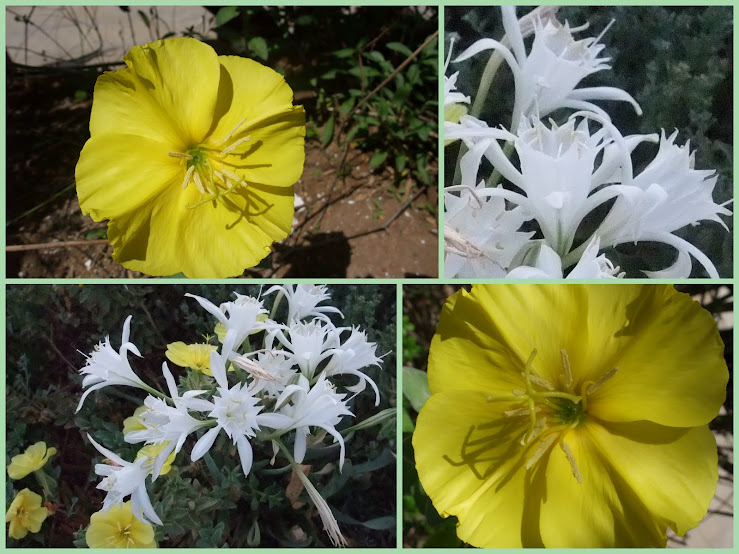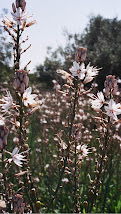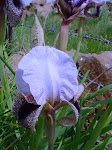Anemones come in many colours beside red

- here are some beautiful lilac ones
Tuvia's iris
Beautiful
The rarest of irises
In the last few weeks I have had the good fortune to visit both the Golan and the Negev. In both places, surprisingly enough, I saw wild irises in bloom.
In 1948 the ill-fated Lamed Hey were ambushed in the Ela valley as they tried to come to the aid of the besieged defenders of Gush Etzion. One of the 35 young heroes who gave his life that day was Tuvia Kushnir.
All his too short life he was a lover of flowers and had gone on many a field trip seeking them out. On one such trip, he wandered into Jordan and was arrested by the Jordanians, as they thought he was a spy. Who would believe that an Israeli would stray into Jordan looking for a flower? But they did, and he was released unharmed.
Tuvia discovered an iris that at first was thought to be the Irus Eretzisraeli or Iris palaestina but it turned out to be a much rarer relative, unique to Israel. This beautiful and rare flower is found in the wilds of the Negev desert north of Mitzpeh Ramon.
To my immense joy, I found and photographed one at Borot Lotz, not far from a desert cystern dug three thousand years ago by the Children of Israel.
The swamp iris

What an intricate flower the Grant Duff's iris is.
Egg yolks

Lovingly encircled
Monday, November 16, 2009
A delightful trip to the Birya forest
The Hebrew name refers to the fact that the flowers look from a distance as if someone has smashed egg yolks on the ground! No leaves, barren earth all around,the Sternberger clusiana is a dramatic site to behold.
As you can see from the photos we succeeded in our quest - these lovely blooms were discovered just a kilometre from the end of our trek!
They were well worth the wait!
We Israelis love our wild flowers and will travel long distances to see them. A delightful tradition has grown up around the Sternbergia. Perhaps someone noticed that the delicate flower was being trampled by the very enthusiasts who had set out to view it, and so he or she decided to protect it! Now you can often find the flowers surrounded by a ring of stones. Look in the picture above and you'll see the circle.
By the way, the Sternbergia has its own defences. The winter months are not the optimum time for being pollinated. So it has two clients! Honey bees collect nectar and pollen from the shorter inner whorl of stamens. The hover flies visit the outer appendages and the longer stamen whorl.
Our Sternbergia is a genus of the Amaryllidaceae family. Although it looks a bit like a crocus, it is more closely related to the narcissus.
A lovely white flower. Is THIS a crocus?
I found these lovely flowers growing happily out from a grassy tuft high up on the mountain. They were obviously delighted with the heavy rains we had just a couple of weeks ago and made their appearance soon after.
Ain't nature amazing?
Sunday, October 11, 2009
Naked ladies
Luckily a good deal of our climb was in the shade of the local oaks and pine trees that adorn these slopes, so we were saved from dehydration. That and the HEAVY bottles of water that we carried.
Stopping for breath, and to enjoy the view I was delighted to spot this tiny and incredibly delicate looking flower growing out of what would seem to be the most inhospitable soil imaginable. In a crevice in the lime-stone rock, pushing up through the fallen pine needles. No leaves, just a single perfect flower. You can see where the popular name naked lady comes from.
Wrongly called a crocus so often that another one of its names is “false autumn crocus”. It is actually a member of the lily family. It’s fancy Latin name is colchicum decaisnei. In Hebrew it is called stavanit bakira – stav is Hebrew for autumn so this roughly means little autumn one! Bakira is the season of the first rains – quite a mouthful.
There is no true autumn in Israel. Although there are many trees that do quietly lose their leaves, there is no glorious show of autumnal colours so common in Europe and North America. Indeed the Bible speaks of only two seasons, summer and winter, so this lovely description is very apt. We hope!
Medicinal value: the dried corm or dried seeds contain colchicine which possess emetic, diuretic, and cathartic action, and are used to treat gout.
Saturday, September 12, 2009
Autumn is officially here!
Actually summer seems reluctant to let go as temperatures which had dropped to a pleasant 28 soared again yesterday to the upper 30s, but we are getting there.
Interestingly in Bible times there were only two seasons, summer and winter. Guess when you are a farmer that is all you are interested in.
Urginia maritima, the sea squill, is known in Hebrew as Chatzav (ch as in Loch). The root of the word means hewing, or digging down through rock. The word for a quarry is machtzavah.
While today we just enjoy the sight of this stately flower, in olden days the squill had a more pragmatic function. Clearing a field for agricultural purposes was always a difficult task. Rocks and unwanted indigenous plants would have to be combatted.
Not surprisingly in a land where water is a precious commodity, the rains falling briefly and unreliably only in the winter period means that for plants to survive they have to put their roots deep into the earth, or develop some other survival techniques. The squill goes deeper than many. When digging it out, if any part of the bulb is left it regenerates.
Thus, when the squill made its end of summer appearance it would clearly delineate the borders of the cultivated fields. Obviously no farmer could sneakily plant a row of these stately plants in an attempt to enlarge his portion! By the way, there is a clear edict in the Bible forbidding tampering with your neighbour’s boundaries (Deuteronomy 19:14) so clearly this is not only a modern problem.
The toxic compounds in the squill can cause blistering of the skin after handling the plant. This effect would certainly discourage malicious individuals from uprooting the plant to obscure property lines. However, with forward planning it could be planted for future use as a border. Presumably by someone wearing gloves.
The Talmud (Baba Batra 55a) describes this as a common practice, and states that Joshua planted it to delineate the borders of the tribes of Israel after the apportionment of the land (Baba Batra 56a).
Pity they didn’t use it instead of the Green Line (made by a green crayon on a crude map) in 1948! Could have saved us a lot of heart-ache.
Wednesday, July 22, 2009
And G-d said "Let the earth put forth vegetation, plants yielding seed, and fruit trees bearing fruit in which is their seed, each according to its kind, upon the earth.
And it was so ... And G-d saw that it was good."
Genesis/ Bereshit 1:11:12
Since Eve persuaded Adam to take the first bite of the forbidden fruit, man's destiny has been tied up with the earth!
And think about it ladies. G-d chastised Adam for his wrong-doing and what did he say?
"She made me do it."
Now my destiny is tied up with getting this book finished.
Then I have to get it published.
Then the hardest of all, I have to get people to buy it.
So watch this space, and now and then I will update you on how things are going!
Have a great day.
What a delight it has been searching for and photographing our wonderful wild flowers. 2700 species in Israel so I have hardly scratched the surface.
I am not an expert photographer but my amazing digital camera makes me seem like one.
The glorious Poleg irises

This area of the Netanya cliffs is slated to disappear beneath a housing development. But the area alongside will be saved. And willing volunteers are lovingly digging up and replanting the iris rhizomes in the protected place.



















